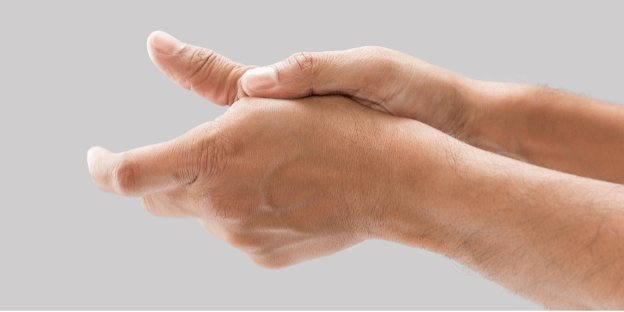How to Identify and Treat a Sprained Thumb
- Category: General
- Posted On:

A thumb sprain happens when you stretch one or more of the ligaments attached to the thumb too far. Sometimes called gamekeeper’s thumb or skier’s thumb, this type of sprain usually involves an injury to the ulnar collateral ligament.
The most common way people get a sprained thumb is by falling on it. However, other forceful or repetitive movements can cause a sprain injury. People who play sports like football or rugby can also get a sprained thumb.
Types of Thumb Sprains
Medical professionals use a system to determine the severity of a sprain. If you seek medical help, the staff will assess your thumb sprain and classify it by grade. The grades, or levels, are:
- Grade 1: This type of sprain means you have overstretched a ligament, but there is no tear.
- Grade 2: This moderate sprain involves both overstretching and some tearing of one or more ligaments.
- Grade 3: The most severe sprains can result in a complete tearing of one or more ligaments, including a bone fracture.

Symptoms of a Thumb Sprain
Pain is the most common symptom people notice when they have a thumb sprain. But there are other symptoms that you may notice that a thumb sprain may cause, including:
- Bruising and swelling
- Difficulty grasping objects or moving the thumb
- Feeling a lump form in the thumb
- Feeling that the thumb feels loose or unstable
You may not know how serious your thumb injury is. People can experience pain and symptoms differently. It is essential to seek medical help when you injure your thumb ligaments. Grade 2 and 3 sprains may require a splint or surgery to help prevent permanent damage to the thumb.
How to Treat Thumb Sprain
Over-the-counter pain relievers can help you manage discomfort and swelling. But if you still have significant pain or instability in that joint, you should seek medical attention.
Medical staff can examine your thumb and use imaging, such as X-rays and CT scans to look for more serious injuries. But you can also get some relief from some of the symptoms at home. To prevent swelling, try to keep the sprain elevated. Compression can help apply pressure to reduce swelling and stabilize the joint.
Using ice for short periods can relieve pain and help keep swelling down. You should also avoid trying to use the injured thumb and rest it as much as possible. If your doctor gave you a splint, brace or cast, keep it on or use it as directed.
You may need surgery for a severe thumb sprain to repair the torn ligament and fracture. After your surgery, you may need to wear a cast for 6 to 12 weeks to allow the injury to heal completely.

Trust UF Health Emergency & Urgent Care Center When You Have a Serious Thumb Injury
A serious thumb injury can be excruciating and lead to a severe condition when not treated promptly. At UF Health Emergency & Urgent Care Center, our primary goal is to provide the residents of Northeast Florida with exceptional service and the proper billing for the care they need. Our combined emergency room and urgent care are fully equipped to handle everything, from allergies to fractures, to fever and chest pain, with on-site labs, X-ray, ultrasound and CT imaging, all under one roof. The ER and urgent care centers are open 24 hours a day, 7 days a week. No appointment is necessary — just walk in!
Find the UF Health Emergency & Urgent Care Center in Jacksonville nearest you at www.euc.ufhealthjax.org/locations.
